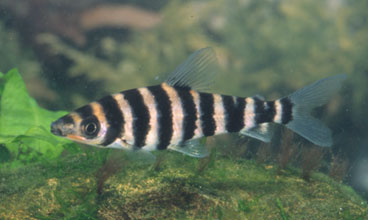Black Banded Leporinus
Leporinus Fasciatus Scientific Name: Leporinus fasciatus fasciatus
Sat, 12th July, 2025 - 4:26 am GMT
Sponsor Ads:

Alternative Name
Leporinus Fasciatus Scientific Name: Leporinus fasciatus fasciatusBasic Info
At a mature age, the Black Banded Leporinus can grow to be quite large, up to twelve inches. In addition, as they grow older, their defining black and yellow horizontal stripes divide by two, increasing the number of stripes on their body. The number of stripes will peak at ten. The word Leporinus is French for 'little hare'. When examined closely, two buck- like teeth can be seen sticking out of their mouth, much like a hare. The Black Banded Leporinus has pointed fins and will occasionally display a red tone underneath their mouth. This is a natural coloration.
Health
Being that they are found in fast flowing rivers, the Black Banded Leporinus should have a power head in its tank. This will simulate the strong currents it is accustomed to and will give the fish plenty of exercise. The Black Banded Leporinus is an excellent jumper, and will not hesitate to jump out of its tank if there is not a cover on it. They like water temperatures from 72 to 79 degrees fahrenheit and a pH level for five and a half to seven and a half. For the most part, Black Banded Leporinus are herbivores. They should be feed vegetables, such as lettuce, chickweed, watercress and cooked peas. Also, live plants make great sources of food. Breeding There have been a few reports of the Black Banded Leporinus breeding in captivity, but it is extremely rare, if possible at all. The two sexes are indistinguishable and no breeding techniques have been unveiled.Habitat
Fresh water fish - They are found in rivers with rather strong currents.Behavior
The Black Banded Leporinus is an impressive fish. Its yellow and black stripes, in addition to its size, make it a desired fish for many aquarists. In addition to its relative ease of care, the Black Banded Leporinus is an excellent fish to own. Black Banded Leporinus are a peaceful fish, when kept with fish of similar size. They should be kept in large schools. They will sometimes quarrel with each other, but less so if the school is larger. Overall, they fit well into community aquariums with larger fish. Black Banded Leporinus should be kept in large tanks, with plenty of rocks and plants to play in. Live plants are acceptable. Beware, however, as the Black Banded Leporinus enjoys eating live plants. The Java Fern is a good choice to keep with the Black Banded Leporinus.Origin
South AmericaHistory
Black Banded Leporinus are originally from South America, Venezuela to be exact. The Black Banded Leporinus is part of the Characin group and of the Anostomidae family.Common Foods
They have been known to eat smaller fish that share its tank and to nip at the fins of other small fish.Sponsor Ads:
No class of Americans has ever objected to any amount of government meddling if it appeared to benefit that particular class. -- Unknown
Black Banded Leporinus
Coded by: BGID® | ALL RIGHTS RESERVED Copyright © 2000-2025
Disclaimer | Privacy | Report Errors / Contact | Credits








 Preparing For China. China is growing their military. China Military Technology - can it keep up with the US?
Preparing For China. China is growing their military. China Military Technology - can it keep up with the US?  versus
versus 

 versus
versus 
 This Thread is about the North Korean Military itself - the kind of army, navy, and air force they have.
This Thread is about the North Korean Military itself - the kind of army, navy, and air force they have. 
 versus
versus 
 versus
versus  versus
versus